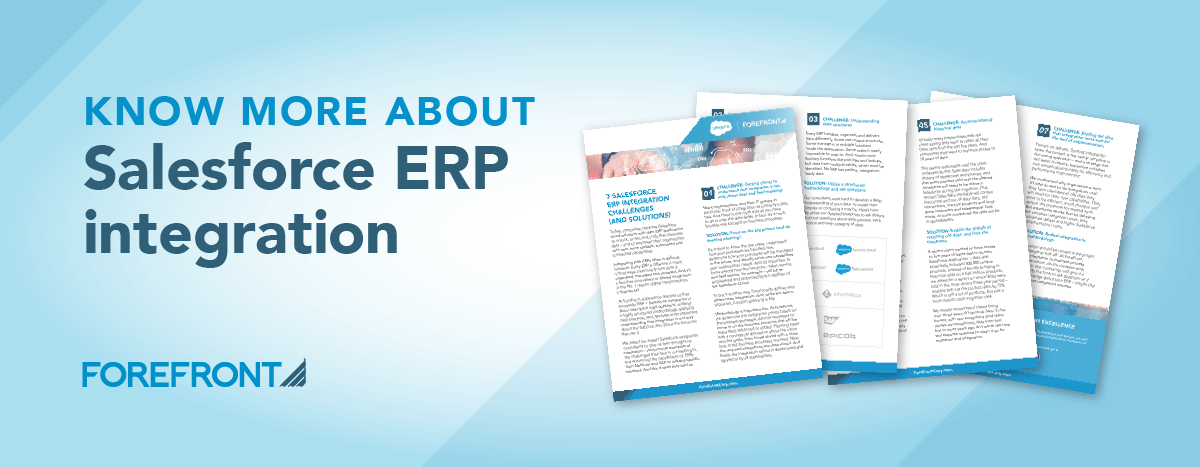
Expert Q&A: How Salesforce Manufacturing Cloud Solves Today’s Difficult Demand Forecasting Challenges
Manufacturers are struggling to produce accurate, timely forecasts in today’s constantly changing, increasingly complex business environment. But the ability to rapidly forecast (and re-forecast) has become critical to success. For many companies, the root of the problem is their ERP solution’s limited capabilities. Or that they’re doing their forecasting on spreadsheets.
We asked one of ForeFront’s manufacturing experts, VP of Manufacturing Practice Chris Cook, for insight into today’s forecasting challenges – and how Salesforce Manufacturing Cloud solutions can give companies the capabilities they need to stay in front. Here is an edited version of the conversation:
Let’s start with the basics: What are the typical forecasting issues for manufacturers?
Chris Cook (CC): Many of today’s forecasting problems are the same problems manufacturers have had forever, only now “getting close” isn’t good enough.
Here’s what forecasting typically looks like for many mid-size manufacturers: I have existing customers that buy the same products over and over in roughly the same quantities, so that piece of the forecast is based on historical data. We also ask them how many units they plan to buy in the coming year, which may be a guess on their part, and figure that in.
Then there are customers that I haven’t done business with, but expect to. If one of these companies is buying 5,000 units from a competitor, we need to estimate how many they will buy from us. They probably are not going to switch completely to our product right from the start, so we need to project that ramp-up. And there’s no guarantee that we will end up with all that business. So, I need to make assumptions in order to forecast that demand.
I’ve also got customers that are going to stop buying my company’s products. Do I know which ones they are? Maybe. Maybe not. And then there may be changes in the marketplace, business environment and economy. I have to guess, if I can anticipate these factors at all, what effect they will have on my sales.
You’ve got messy, unreliable data from multiple sources, as well as a large number of factors that make it difficult to rely on those numbers, especially when they’re aggregated, and know what demand is going to be at a point in time.
What is the key to faster and more accurate forecasting?
CC: It starts with better data. You have to normalize and then analyze and understand the information from historical purchases. And you have to get sales reps to use Salesforce in a way that enables more reliable projections of future business. That’s the foundation of better forecasting. And that’s what Salesforce Manufacturing Cloud provides.
How does Salesforce and Salesforce Manufacturing Cloud enable more complete and accurate forecasting?
CC: The key questions – “How much are you going to sell?” and “When are you going to sell it?” – are more complicated than they seem. Let’s say a rep sells a deal for $350,000 per year. But, really, it’s a deal for $50,000 a month starting in June. So, you’re going to move $50,000 of product in June, July, August, September, October, November and December.
That’s the concept of what Manufacturing Cloud calls a Sales Agreement. It’s an agreement that structures how an order will be placed and when it will be placed. It enables the sales rep to capture potential business in Salesforce in the form of ongoing or recurring revenue versus a single annual all-or-nothing amount.
Manufacturing Cloud also asks you which product/SKU you’re going to sell. Or if the sales rep doesn’t know, from what product family are you going to sell.
Plus, you can factor in, and normalize, the probability that you’re going to win the deal. If I’m selling $10,000 of product per month to Acme Co., and that business has been solid – it orders $10,000 of product on the first day of the month, every month, for the past five years. That’s 100% probability.
I’m also trying to sell my products to a new customer, Apex Inc. The buyer says they’re interested in $10,000 of product per month too. But I’m only 50% sure that the business will happen, so I can normalize to $5,000.
Market changes can be accommodated, too, in Manufacturing Cloud. If we sell batteries, and we believe the demand for lithium-ion batteries will increase 30%, we can take last year’s orders and apply a 30% uplift.
Another example is, say my company sells fertilizer. Nobody buys fertilizer in January. All our sales are between March and August. If my sales rep says he’s got a deal to sell $250,000 of our products to XYZ distributor, I can take that $250,000 and apply a seasonal curve to it – a curve I can customize based on sales history.
Manufacturing Cloud provides a structure for, and aggregates, your data in a way that makes sense for planning purposes, but it goes another step further. So you can say, for these industries, for these product types, for these geographies, for these market segments, for virtually any variable, you want to apply a rule. That rule can be a seasonality curve. It can be a percentage increase over last year’s business because of market growth. It can be a decrease due to new competition. It can be whatever you need.
Many ERPs offer demand planning capabilities. Why not use those tools?
ERPs do offer forecasting tools. But Manufacturing Cloud offers a more sophisticated, reality-based approach. Because all the data “lives” in Salesforce – and all of it is connected.
With, say, SAP, you have an Excel spreadsheet that gets sent to the sales team, which fills it out based on the data they have available in the system, data they keep on their own spreadsheets, data they keep on notepads, or data they have in their heads. And then Operations has to upload the projected sales data into SAP and run the forecast. SAP can apply variables, curves and product-specific changes and most of the capabilities Manufacturing Cloud does, but it’s all built on potentially unreliable numbers. And it’s a lot more work.
Manufacturing Cloud offers a fundamentally different, faster and easier approach. And when you take this approach and gather information in a single location, the quantity and quality of your forecasting information is better – and it gets better and better as time goes on. And, you can easily re-generate forecasts on demand as sales data and circumstances change.
Want to know more about our Salesforce Manufacturing Cloud solutions?
View this on-demand webinar to learn how a Salesforce Manufacturing Cloud solution can solve today’s difficult forecasting challenges. And for valuable insight into the benefits of a Salesforce Manufacturing Cloud solution, contact Chris Cook at ccook@forefrontcorp.com.







